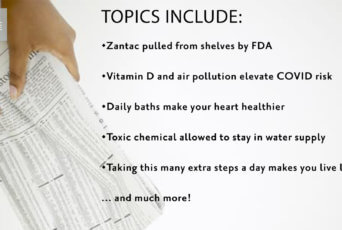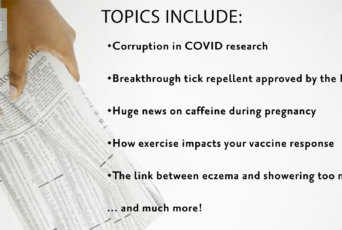A lot of people think of tuna as a healthy food, and in some ways it is: it’s packed with protein, naturally sugar-free, and has a ton of important nutrients, like omega-3 fatty acids and vitamin B12. But despite all these benefits, it’s not something that you should eat all that often (or if you’re pregnant or have high mercury levels in your blood, perhaps not at all). Why? Because of its mercury content. Most of us have a general idea that too much mercury is bad, but what exactly does it do to your body, and how much is too much? Read on to learn the signs of mercury poisoning, the primary sources of mercury (including the foods high in mercury besides fish), options for mercury poisoning treatment, and more.
You can also listen to Adrienne read this guide on The WellBe Podcast.
Mercury 101
Before we get into things like the signs of mercury poisoning and sources of mercury, let’s first unpack the basics about mercury.
Mercury is a naturally occurring element found in the rock of the earth’s crust. It comes in several different forms, including metallic mercury, inorganic mercury, and organic mercury, also known as methylmercury. Methylmercury is the type of mercury that most humans are exposed to, as it exists in some foods that we eat, and it is highly toxic.
Various things can release mercury into the air: volcanic activity, the erosion of rocks, and human activity like coal-fired power plants, waste incinerators, mining, and industrial processing, among others. Once it gets into the air, it can make its way onto plants and organic matter, where it’s transformed by bacteria into methylmercury. From there, it bioaccumulates, meaning it is absorbed by an organism (fish, humans, etc.) more quickly than the organism can get rid of it.
Recognizing the Signs of Mercury Poisoning
Nearly all humans have some level of mercury exposure, and as long as that exposure remains trivial, it generally doesn’t have a negative effect. But if you consume or are exposed to too much, it can cause serious health problems. What’s more, it doesn’t take much exposure for there to be negative health repercussions, which is why the WHO considers mercury to be one of the top ten chemicals of major public health concern.
The U.S. government recommends that you keep your blood mercury levels below 5.0 micrograms per liter, and the EPA advises consuming no more than 0.045 micrograms of mercury per pound of body weight a day (so if you weigh 100 pounds, you can safely consume 4.5 micrograms of mercury per day; for reference a can of tuna has around 30 micrograms). Many people go over that limit, though: one study found that 89% of the people they tested had blood mercury levels above the recommended limit. That’s because there are sources of mercury we know we are consuming, like choosing a tuna salad, and others we don’t know we are consuming, because they are in our air, water, and other things like shots.
Mercury exposure is an even bigger concern for certain groups, specifically young children and pregnant and breastfeeding mothers. Because the amount of mercury you can safely consume depends on your body weight, young children can get mercury poisoning much more easily than larger adults. Mercury has also been shown to pass from a pregnant mother to her fetus and from a nursing mother to her baby through breastmilk, threatening development in both cases.
The symptoms and signs of mercury poisoning are quite varied, as it can have toxic effects on the nervous, digestive, and immune systems as well as lungs, kidneys, skin, and eyes.
Some signs of mercury poisoning include:
- Impaired cognitive function (such as poor memory and difficulty paying attention)
- Impaired motor function (such as clumsiness or loss of fine motor skills or dexterity)
- Memory loss
- Insomnia
- Fatigue
- Muscle weakness
- Dizziness
- Headaches
- Kidney dysfunction
- Tremors
- Anxiety or depression
- Behavioral changes, like irritability or excitability
- Numbness or tingling
Beyond the troubling signs of mercury poisoning, there are also concerns about the way in which mercury consumption may increase your risk of certain conditions. Some research suggests that high mercury levels are associated with an increased risk of neurological diseases like Alzheimer’s and Parkinson’s. There’s also significant research linking high mercury levels to cardiovascular problems, such as high blood pressure, high cholesterol, and heart attacks. In one study of 1,800 men, researchers found that those with the highest mercury levels were two times as likely to die from cardiovascular problems than those with low levels.
The Main Sources of Mercury for Humans
When you think of sources of mercury, you probably think of tuna, and rightly so: nearly all methylmercury exposure is due to consuming fish and shellfish that contain high levels of methylmercury. This is because when mercury is released into the environment, much of it makes its way into sea water, where it is then absorbed by plants like algae. Fish then eat the algae, absorbing its mercury. As smaller fish that have eaten mercury-containing algae are consumed by larger fish (and then those fish by still larger fish), the mercury accumulates.
As a result, fish toward the top of the food chain can have mercury concentrations that are 10 times higher than the fish they eat. Because of this, large fish with longer lifespans — like swordfish, shark, marlin, king mackerel, and, yes, certain kinds of tuna (albacore, big eye, and yellowfin, which are all larger tunas) — are the primary sources of mercury for humans.
But you don’t need to swear off seafood — in fact, if you eat seafood, experts advise that you keep it in your diet because of all the important nutrients that fish and shellfish provide (such as omega-3s, protein, minerals, and more). Rather, you just need to be cognizant of the mercury levels of different seafood, and make your choices accordingly. Low-mercury seafood choices include anchovies, sardines, salmon, crab, shrimp, oysters, trout, sole, scallops, flounder, catfish, and haddock, among others. If you eat fish regularly, these are all safe options to eat and serve to your family. And if you love tuna or swordfish or other major sources of mercury, you don’t need to swear them off forever — just understand your mercury levels through a blood test and then adjust your intake accordingly. For someone that doesn’t have high levels of mercury, they might be able to have tuna or swordfish as much as once a week, while others might do better with just once a year. No matter how much you eat, opt to have any high mercury fish cooked rather than raw, as cooking is known to reduce mercury content in fish by up to 30%! Women who are pregnant or nursing, however, should avoid high-mercury fish entirely.
While fish is the main source of mercury for humans, there are foods high in mercury besides fish. One study showed that among people who don’t eat seafood, those who consumed wine, rice, vegetable oil, liquor, beans, nuts, or soy all had higher blood mercury levels than those who didn’t consume much or any of these foods. This is because the mercury in the air ends up in vineyards, rice paddies, and soy and other cropland.
There are also non-food sources of mercury, though these are much less common and not generally a concern for the average person. For instance, metallic mercury exists in some thermometers, CFL light bulbs, some dental fillings, and certain types of jewelry; however, for a person to be exposed to the mercury in all of these cases, the mercury would need to be released by some breakage (i.e., a thermometer breaking in someone’s mouth, or a light bulb shattering). For dental fillings, mercury from the filling evaporates and is then inhaled and absorbed into the bloodstream.
People may also be exposed to mercury through their occupation. Mercury exposure is a particular concern for mine workers and those who work in some chemical manufacturing plants and facilities that either manufacture mercury-containing products or use instruments that contain mercury.
Mercury Poisoning Treatment
Mercury poisoning can be diagnosed with a blood or urine test that measures mercury levels in the body, along with a patient’s symptom profile and information about their lifestyle and diet. However, mercury can be tricky to detect, so some experts recommend doing a combination of blood, urine, and hair testing to make it less likely that high mercury levels are detected (the Mercury Tri-Test by Quicksilver Scientific is one good option). However, even once it’s diagnosed, there’s not a simple mercury poisoning treatment.
The most important thing to do is simply to remove all the sources of mercury in a person’s life: if they eat a lot of high-mercury fish, they need to stop completely; if they work in an environment where they’re inhaling mercury, they need to find a different job or job duty. If you cut out your sources of mercury, then your body can begin to eliminate mercury from the body faster than you accumulate it, allowing your mercury levels to drop.
Depending on your body’s ability to detoxify (perhaps you have a genetic mutation or several on your detoxification pathways) or if your mercury levels are extremely high, your doctor may need to do chelation therapy. Chelation agents are substances that can bond to — or bind — metals in your blood, which then allows them to exit your body through urine. If your mercury poisoning treatment involves chelation therapy, you can get the chelation drugs into your body either via IV or pill form. To completely remove the metal from your body, you may need to take chelation drugs for several weeks or even months. However, chelation therapy carries serious risks, and can even be fatal. While it is usually safe for mild cases, those with moderate to severe mercury poisoning can experience excessive nutritional depletion and cellular breakdown, which then exacerbates the mercury poisoning symptoms. Anyone considering chelation therapy should consult with a subject matter expert to ensure that it’s safe for their particular case.
Toxin binders are another, safer option for mercury poisoning treatment. Binders are substances specific compounds that bind up toxins, allowing your body to more easily eliminate them via urine, poop, or sweat. Charcoal is a common binder that can be used for lowering mercury levels. However, even though charcoal binders are safer than chelation drugs, the process of detoxing mercury out of your body is tricky, so it’s best to work with a holistic doctor for both mercury poisoning testing and detoxification help. If you need help finding someone to help you do this, WellBe can help.
The WellBe Takeaway on Mercury Poisoning
Mercury is highly toxic, and we all need to be aware of and vigilant about avoiding its negative health effects. Here’s what to remember about mercury and your health:
- Mercury is a naturally occurring element that exists in the rock of the earth’s crust. It is released into the air via things like volcanic activity, erosion, and human activity. From there it makes its way into water, soil, and plants
- There are several types of mercury. The type that humans are exposed to most is mercury’s organic form, methylmercury, which is highly toxic.
- All humans have some level of mercury exposure. At subthreshold levels, that’s fine. But exposure that’s even slightly above the recommended amount can lead to serious and sometimes long-lasting health issues. This is even more true for sensitive groups, like young children and pregnant or nursing mothers. Experts recommend that you consume no more than 0.045 micrograms of mercury per pound of body weight per day, and keep your blood mercury levels below 5.0 micrograms per liter.
- The signs of mercury poisoning are quite varied, as it can affect many systems in the body. Common symptoms include cognitive and neuromuscular issues, as well as fatigue, headache, tingling or numbness, and behavioral changes.
- Fish and shellfish are the main sources of mercury for humans. This is because mercury makes its way into sea plants like algae, which are then eaten by smaller fish, which are then eaten by larger fish. As you go up the food chain, the mercury bioaccumulates. For this reason, large fish like swordfish, shark, king mackerel, and tuna have higher concentrations of mercury than smaller fish. You should strictly limit your intake of these fish or avoid them completely.
- There’s no simple mercury poisoning treatment. The main thing to do is to simply cut mercury sources out of your diet so that your body can begin to process and eliminate what it has built up. If your mercury levels are extremely high or you have genetic mutations making it hard for your body to detoxify the mercury on its own, you may need toxin binders like charcoal. In some cases, you may consider chelation therapy, which is when you take drugs (via IV or pills) that bind to the metal in your blood, allowing it to be eliminated through urine, though this carries serious health risks and is only for mild cases of mercury poisoning. It is best to work with a holistic doctor for mercury poisoning testing and detoxification. WellBe can help.
If you eat fish or shellfish, do you try to avoid or limit your intake of high-mercury fish? If so, what do you eat instead? If not, how could you change your diet to lower your mercury consumption? Tell us in the comments below.
Listen to this guide on The WellBe Podcast.
Citations:
- Hightower JM, Moore D. Mercury levels in high-end consumers of fish. Environ Health Perspect. 2003 Apr;111(4):604-8.
- Yokoo EM, Valente JG, Grattan L, Schmidt SL, Platt I, Silbergeld EK. Low level methylmercury exposure affects neuropsychological function in adults. Environ Health. 2003 Jun 4;2(1):8.
- Zahir F, Rizwi SJ, Haq SK, Khan RH. Low dose mercury toxicity and human health. Environ Toxicol Pharmacol. 2005 Sep;20(2):351-60.
- Salonen JT, Seppänen K, Nyyssönen K, Korpela H, Kauhanen J, Kantola M, Tuomilehto J, Esterbauer H, Tatzber F, Salonen R. Intake of mercury from fish, lipid peroxidation, and the risk of myocardial infarction and coronary, cardiovascular, and any death in eastern Finnish men. Circulation. 1995 Feb 1;91(3):645-55.
- Guallar E, Sanz-Gallardo MI, van’t Veer P, Bode P, Aro A, Gómez-Aracena J, Kark JD, Riemersma RA, Martín-Moreno JM, Kok FJ; Heavy Metals and Myocardial Infarction Study Group. Mercury, fish oils, and the risk of myocardial infarction. N Engl J Med. 2002 Nov 28;347(22):1747-54.









I have high mercury toxicity from dental mercury and was fortunate to learn in time that in the case of high mercury toxicity chelation is quite dangerous. One of the mercury detox experts I spoke with responded to my question about chelation by saying “Chelation? Does that come with a coffin, cuz you’ll need it.” Moderate to severe cases need a long, slow detox. Chelation is only safe for mild cases. I’m on a mercury detox protocol originated by a Dr Kinghardt of Switzerland, overseen by Connie Fox of http://www.mercurymadness.info.
Hi Tracy! Thank you for sharing and we are so sorry to hear that you have had to deal with mercury toxicity and all that comes with it! We deeply appreciate your insight on chelation therapy and the indications for mild versus severe toxicity. It’s great to hear that you have found knowledgable experts to help guide you through this process, and we wish you all the best on your healing journey!
Xx Adrienne and Team WellBe